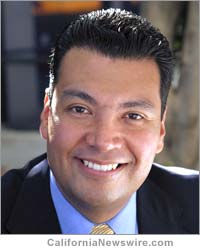 LOS ANGELES, Calif. /California Newswire/ — “Three weeks ago, the California Institute of Technology and the Japan Agency for Marine-Earth Science and Technology published a study concluding for the first time that a statewide California earthquake involving both the Los Angeles and San Francisco metropolitan areas may be possible. This morning I introduced legislation to create a statewide earthquake early warning system,” said Calif. Senator Padilla at a press conference held in the Seismological Laboratory at California Institute of Technology (Caltech).
LOS ANGELES, Calif. /California Newswire/ — “Three weeks ago, the California Institute of Technology and the Japan Agency for Marine-Earth Science and Technology published a study concluding for the first time that a statewide California earthquake involving both the Los Angeles and San Francisco metropolitan areas may be possible. This morning I introduced legislation to create a statewide earthquake early warning system,” said Calif. Senator Padilla at a press conference held in the Seismological Laboratory at California Institute of Technology (Caltech).
Padilla, joined by a panel of seismologists representing Caltech, UC Berkeley and the U.S. Geological Survey said, “California is going to have an earthquake early warning system, the question is whether we have one before or after the next big quake.”
Building upon the California Integrated Seismic Network, seismologists envision a system that would process data from an array of sensors throughout the state. The system would effectively detect the strength and the progression of earthquakes, alert the public within seconds and provide up to 60 seconds advanced warning before potentially damaging ground shaking is felt.
“A fully developed earthquake early warning system would provide Californians critical seconds to take cover, assist loved ones, pull to the side of the road, or exit a building. It could allow time to stop a train or power down other critical infrastructure,” Padilla said. “The earthquake warning would not only alert the public, it would also speed the response of police and fire personnel by quickly identifying areas hardest hit by the quake,” Padilla added.
“For decades Caltech and UC Berkeley have worked with the U.S. Geological Survey on science that can help the public in the event of a major quake. Earthquake Early Warning is a ripe area for development of a system that can provide a few seconds to tens of seconds of advance notice for many people in the event of a major earthquake. We firmly believe Earthquake Early Warning would save lives and help California in many ways if it is rolled out as a fully operational system,” said Dr. Michael Gurnis, Professor of Geophysics and Director of the Caltech Seismological Laboratory.
“The Gordon and Betty Moore Foundation supports the earthquake early-warning system because when it comes to earthquakes, one minute matters for getting more people to safety and activating emergency systems,” said Cyndi Atherton, a Science Program director at the Moore Foundation.
The initial cost estimate for the system is $80 million. Padilla said that with the magnitude 6.7 Northridge Earthquake claiming 60 lives and causing at least $13 billion in damage, the system is an intelligent investment. “About 90% of the world’s earthquakes and over 80% of the world’s strongest quakes occur along the Pacific Ring of Fire. The Ring of Fire includes the very active San Andreas Fault zone here in California. We all know a big quake will hit again in the future. We should be smart and use our advanced science and technology to detect seismic activity and alert people in advance of an approaching quake,” Padilla said.
Indeed, the Uniform California Earthquake Rupture Forecast released in 2008 predicted a 99.7% likelihood of a magnitude 6.7 earthquake in California in the next 30 years and a 94% chance of a magnitude 7.0.
Japan, Taiwan, Mexico, Turkey, Romania, Italy and China either have or are working on earthquake early warning systems.
To read the study on a statewide earthquake go to: http://www.caltech.edu/content/faulty-behavior
Senator Alex Padilla, 39, graduated from MIT with a degree in Mechanical Engineering. He currently serves on the Board of MIT and is President of the National Association of Latino Elected and Appointed Officials. He is Chair of the Senate Energy, Utilities and Communications Committee and represents the more than 1,000,000 residents of the 20th State Senate District in Los Angeles.















